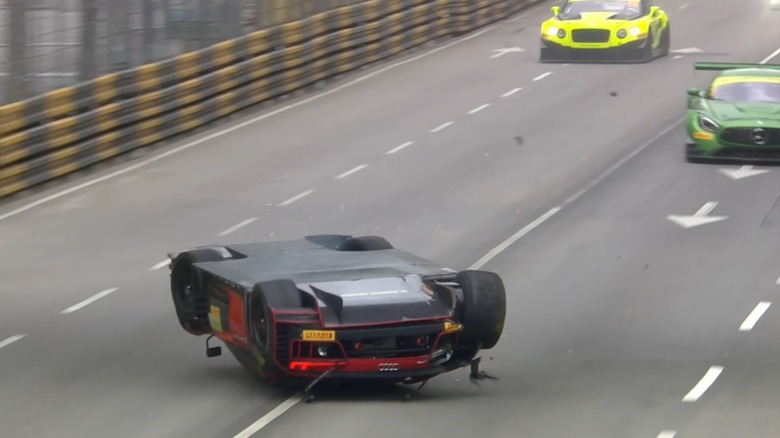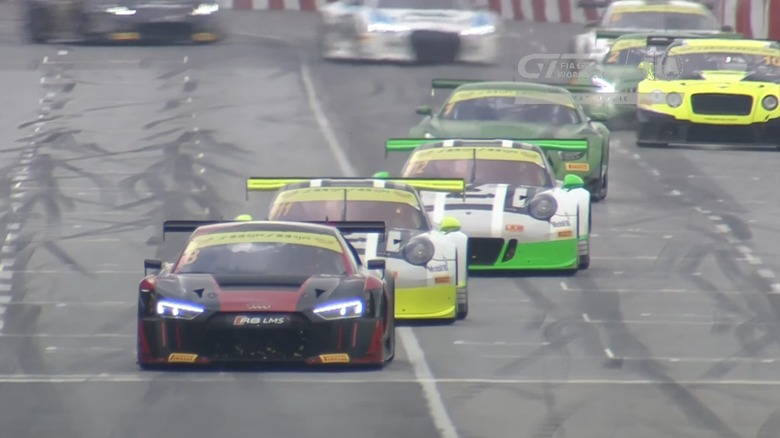The Time A Race Car Driver Crashed His Vehicle & Won The Race Upside Down
Auto racing is one of the least-predictable sporting disciplines out there. A lot can happen when you place dozens of cars in close proximity and instruct them to drive as fast as possible. Stunning victories, great tragedies, and everything in between define a large part of why so many people enjoy motorsports so much. Generally, if it's within the realm of possibility in a racing context, it's probably happened at some point or another on a racing circuit; for better or worse. Of course, we remember series like Formula 1, the World Endurance Championship, or NASCAR for those stunning moments, but the comparatively-less extreme GT World Championship (GTWC) has certainly contributed a number of its own memorable experiences.
Unlike ultra-fast open wheelers, GT racing takes place on circuits utilizing cars that closely resemble the GT cars you might see on the road today, such as the Ford Mustang, Lexus RC F, and Mercedes AMG-GT. These cars are heavily-modified with aerodynamic elements and lightweight bodies, then matched with one another using a system called Balance of Performance (BoP), so no car holds a clear advantage. This ensures close racing between competitors, making driver skill of paramount importance and giving plenty of opportunity for those "Only in Motorsports" moments.
Take, for instance, that time in 2016 when Laurens Vanthoor won a race by skidding down the streets of Macau on his roof. This raises some eyebrows, because anyone who watches the footage can clearly see cars passing him in avoiding action. Why, then, didn't they win and Vanthoor DNF'd? And how on Earth did he even end up on his roof, anyway?
What actually happened
Macau is a notoriously difficult street circuit. It's incredibly narrow, bumpy, and simultaneously boasts one of the highest and lowest-speed corners in all of circuit racing. While this extreme nature has led to criticism, it's also been labeled as one of the most spectacular circuits in the world. When accidents happen here, they tend to be a spectacle. Either multi-car pileups due to no runoff areas and nowhere for drivers to take avoiding action, or violent single-car accidents such as Vanthoor's, occur regularly here.
For instance, just one year later in 2017, there was a massive pileup during GTWC qualifying that blocked the entire circuit at its narrowest point. The circuit itself, then, acts as the first puzzle piece. The second is what happens when a car enters another's slipstream. Slipstream, in racing terms, is the gap in the air left by a leading car. If you closely follow that car, yours will go faster due to not encountering air resistance, but at the cost of less air to effect the aerodynamic devices like wings.
The end result of this is that your car is faster in a straight line, but it brakes and corners more unpredictably because of the difference in air pressure. It's why NASCAR stock cars can be almost as fast in a straight line as F1 cars when following in packs. The scenario played out like this: Vanthoor's Audi was overtaken by Earl Bamber's Porsche, and he went into the Porsche's slipstream during an extremely fast, bumpy corner. His car got unsettled as a result, and understeered into the wall at-speed. The flat underbody caught the wind and flipped the car over, with the Audi skidding to a halt on its roof.
Why it counted as a win
The 2016 Macau GTWC was itself somewhat of a disaster. In fact, cars were only able to compete for about two laps of the 18 scheduled. The safety car led for much of the race, and there was an earlier race suspension from a BMW crashing into a safety barrier. Once workers finished repairing the barrier and the race resumed, there was just 18 minutes of seat time left on the clock, so everyone was in a rush and closely-packed together in what effectively became an impromptu sprint shootout on one of the world's narrowest circuits. An accident was a near-certainty, though perhaps not one this spectacular in nature.
The track was frantically cleared following the wreck, but with only four minutes left on the clock by the time racing could be resumed, officials called it quits and Vanthoor declared the winner, despite being in second-place at the point of impact. Why? Well, instead of tallying the win at the moment the race was red-flagged or the grid that would've restarted, officials instead opted to define the results based on the positions cars were in when they completed the previous lap. So whomever crossed the line onto the start of the incident lap first was declared the winner; that being Vanthoor.
Vanthoor emerged uninjured from the wreckage and took to the podium thanks to his Audi's rollcage, one of the many safety innovations which has made both racing and regular cars safer. His win resulted in Audi taking home the FIA GT World Cup Manufacturer's Trophy that year, as well as one incredible story to share with incredulous friends.

